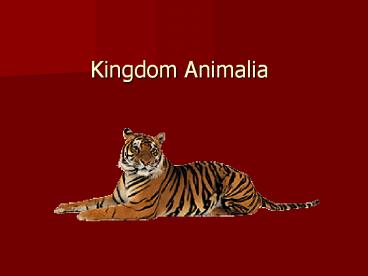Kingdom Animalia - PowerPoint PPT Presentation
1 / 20
Title:
Kingdom Animalia
Description:
Kingdom Animalia ~ Characteristics ~ Multicellular Eukaryotic with no cell walls Heterotrophs (consumers) ~ Characteristics ~ Have a nervous system to ... – PowerPoint PPT presentation
Number of Views:201
Avg rating:3.0/5.0
Title: Kingdom Animalia
1
Kingdom Animalia
2
Characteristics
- Multicellular
- Eukaryotic with no cell walls
- Heterotrophs (consumers)
3
Characteristics
- Have a nervous system to respond to their
environment - Locomotion relates to ability to obtain food
- Most animals develop from a zygote
4
Body Plans
- Animals that are irregular in shape are
asymmetrical. - Animals that are regular in shape are
symmetrical.
5
Body Plans
- An animal has radial symmetry if it can be
divided along any plane, through a central axis,
into equal halves. - An animal has bilateral symmetry if it can be
divided down its length into similar right and
left halves forming mirror images of each other.
6
Which figure has bilateral symmetry? Which has
radial symmetry?
7
Protection and Support
- Though not all animals have a skeleton, those
that do can be divided into two groups - Those with an exoskeleton exterior skeleton
- Those with an endoskeleton interior skeleton
8
Invertebrates
- 8 main phyla
- No backbones
- 95 of all animals are in this group
9
Invertebrate Phylum Porifera
- Examples Tube Sponge, Glass Sponge, Sea Sponge
10
Invertebrate Phylum Cnidaria
- Examples - Jellyfish, Hydra, sea anemones, and
corals
11
Invertebrate Phylum Platyhelminthes
- Examples Planaria and tapeworm.
12
Invertebrate Phylum Nematoda
- Examples
- Hookworm
- Trichinella
13
Invertebrate Phylum Mollusca
- Gastropoda
- snails and slugs
14
Invertebrate Phylum Mollusca
- Class Bivalves
- clams, oysters,
- scallops and mussels
15
Invertebrate Phylum Mollusca
- Class Cephalopods
- squids and octopuses
16
Invertebrate Phylum Annelida
- Earthworms, Bristleworms, leeches
17
Invertebrate Phylum Echinodermata
- Examples seastar, sea urchin, sand dollar and
sea cucumber
18
Invertebrate Phylum Arthropoda
- spiders, horseshoe crabs, scorpions
19
Invertebrate Phylum Arthropoda
- Lobsters, barnacles, insects
20
Vertebrates Phylum Chordata
- 5 classes
- Fish
- Mammals
- Reptiles
- Amphibians
- Birds































